Kiedy próbujemy zalogować się do naszych własnych witryn WordPress, zdarzało się, że strona logowania ciągle się odświeżała i przekierowywała, uniemożliwiając nam dostęp do obszaru administracyjnego WordPress.
Jeśli doświadczasz tego problemu, nie jesteś sam. Problem odświeżania i przekierowywania strony logowania WordPress jest powszechny i frustruje wielu właścicieli witryn WordPress. Biorąc to pod uwagę, przetestowaliśmy kilka wypróbowanych i sprawdzonych metod, aby rozwiązać ten problem.
W tym kompleksowym przewodniku pokażemy ci, jak poprawić problem z odświeżaniem i przekierowywaniem strony logowania WordPress. Zanurzmy się i przywróćmy cię do kokpitu WordPress, abyś mógł odzyskać kontrolę nad swoją witryną!
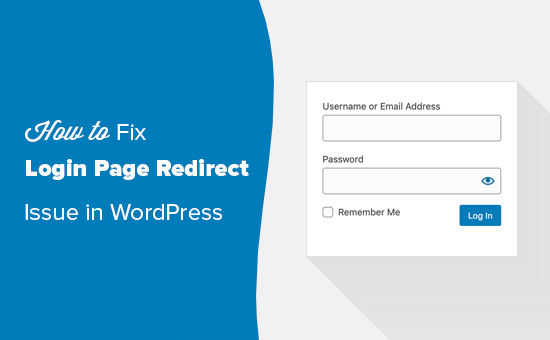
Co powoduje problem z odświeżaniem i przekierowywaniem strony logowania w WordPress?
Błąd odświeżania i przekierowania strony logowania WordPress (zwany również pętlą przekierowania logowania WordPress) jest zwykle spowodowany nieprawidłowymi ustawieniami adresu URL WordPress lub brakiem ustawienia plików cookie logowania.
Zwykle, gdy się logujesz, WordPress weryfikuje twoją nazwę użytkownika i hasło, a następnie ustawia plik ciasteczka logowania w przeglądarce. Następnie przekierowuje użytkownika do kokpitu WordPress.
Jeśli WordPress nie ustawi poprawnie pliku ciasteczka logowania lub twój adres URL obszaru administracyjnego WordPress jest nieprawidłowy, zostaniesz przekierowany z powrotem do ekranu logowania zamiast do kokpitu administracyjnego.
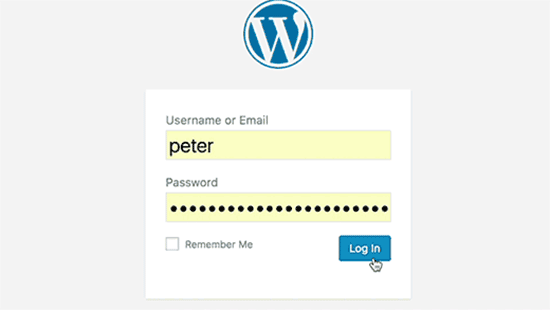
Problemy z logowaniem mogą być również spowodowane różnymi błędami WordPressa, takimi jak błąd nawiązywania połączenia z bazą danych, wewnętrzny błąd serwera lub biały ekran śmierci.
Mając to na uwadze, rozwiążmy i poprawmy problem przekierowania i odświeżania strony logowania WordPress. Możesz użyć tych szybkich odnośników, aby przejść do konkretnej metody:
- Method 1: Clear Cookies to Resolve Login Issues
- Method 2: Update WordPress URL Settings
- Method 3: Delete .htaccess File in WordPress
- Method 4: Deactivate Your Plugins
- Method 5: Revert Back to the Default Theme
- Method 6: Reinstall WordPress Core
- Video Tutorial
- What to Do If You Can't Fix WordPress Login Redirect Issue
Uwaga: Jeśli chcesz wypróbować zaawansowane kroki w tym poradniku WordPress, najpierw utwórz kopię zapasową twojej witryny. Zobacz nasz przewodnik na temat ręcznego tworzenia kopii zapasowej bazy danych WordPress.
Metoda 1: Wyczyść pliki ciasteczka, aby rozwiązać problemy z logowaniem
WordPress używa plików ciasteczek do uwierzytelniania logowania, więc pierwszy krok w rozwiązywaniu problemów z logowaniem do WordPressa jest najprostszy. Musisz wyczyścić pliki ciasteczka i pamięć podręczna twojej przeglądarki.
W przeglądarce Google Chrome wystarczy kliknąć menu ustawień przeglądarki, a następnie wybrać opcję Więcej narzędzi ” Wyczyść dane przeglądania.
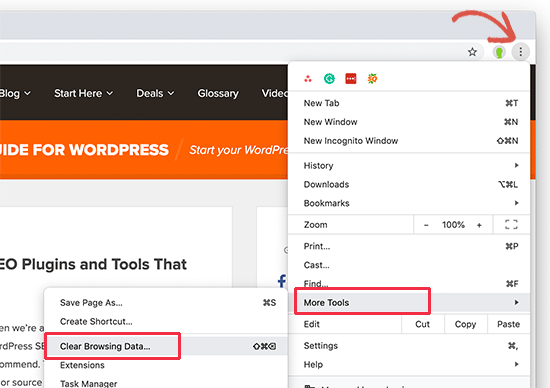
Spowoduje to uruchomienie strony ustawień Chrome z wyskakującym okienkiem “Wyczyść dane przeglądania” wyświetlanym na ekranie.
W tym miejscu należy wybrać opcje “Wyczyść pliki ciasteczka i inne dane witryny” oraz “Pamięć podręczna obrazków i plików”.
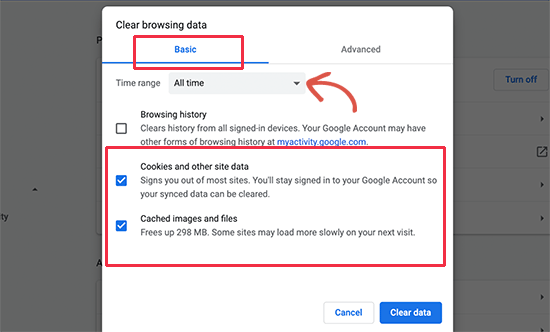
Następnie kliknij przycisk “Wyczyść dane”, a Google Chrome wyczyści pamięć podręczna przeglądarki.
Upewnij się również, że twoja przeglądarka ma włączoną obsługę plików ciasteczka. Następnie uruchom ponownie twoją przeglądarkę i spróbuj się logować. To powinno poprawić problem u większości użytkowników.
Mamy kompletny przewodnik ze zrzutami ekranu pokazujący , jak wyczyścić pamięć podręczną i pliki ciasteczka we wszystkich głównych przeglądarkach.
Metoda 2: Aktualizacja ustawień adresu URL WordPress
WordPress zawiera ustawienia adresu URL twojej witryny internetowej i adresu URL twojej instalacji WordPress.
Jeśli miałeś dostęp do twojego obszaru administracyjnego WordPress, to mogłeś zobaczyć tę opcję na stronie Ustawienia ” Ogólne.
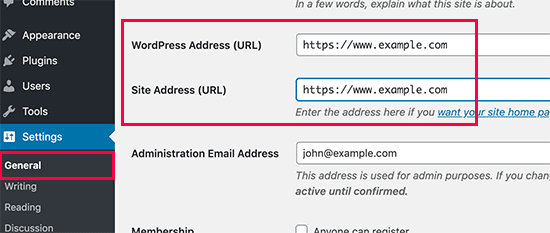
Jeśli te adresy URL są nieprawidłowe, WordPress przekieruje cię z powrotem na stronę logowania.
Ponieważ nie możesz uzyskać dostępu do obszaru administracyjnego WordPress, będziesz musiał edytować plik wp-config.php, aby poprawić ten problem.
Plik wp-config.php to specjalny plik w WordPressie, który zawiera twoje ważne ustawienia WordPressa. Możesz uzyskać do niego dostęp za pomocą klienta FTP lub aplikacji Menedżer plików w kokpicie twojego konta hostingowego WordPress.
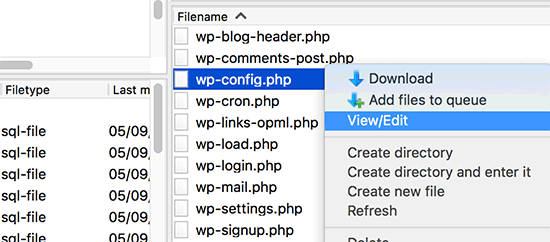
Plik wp-config.php znajdziesz w katalogu głównym twojej witryny. Po prostu edytuj plik i wklej następujące linie kodu tuż przed tą, która mówi: "To wszystko, przestań edytować! Szczęśliwego publikowania".
1 2 | define('WP_HOME','https://www.example.com');define('WP_SITEURL','https://www.example.com'); |
Nie zapomnij zastąpić “example.com” twoją własną nazwą domeny.
Następnie zapisz wprowadzone zmiany i prześlij plik z powrotem na swoją witrynę internetową.
Możesz teraz przejść na twoją witrynę internetową WordPress i spróbować się logować. Miejmy nadzieję, że to naprawiło problem. Jeśli tak się nie stało, kontynuuj czytanie, aby poznać dodatkowe kroki rozwiązywania problemów.
Metoda 3: Usunięcie pliku .htaccess w WordPressie
Czasami plik .htaccess może zostać uszkodzony, co może skutkować wewnętrznymi błędami serwera lub błędem odświeżania strony logowania.
Wystarczy uzyskać dostęp do witryny internetowej za pomocą klienta FTP lub aplikacji Menedżer plików w kokpicie dostawcy hostingu.
Po nawiązaniu połączenia zlokalizuj plik .htaccess w katalogu głównym twojej witryny internetowej i pobierz go na swój komputer jako kopię zapasową.
Jeśli nie możesz znaleźć twojego pliku .htaccess, ten przewodnik o tym, dlaczego może go bra kować, może ci pomóc.
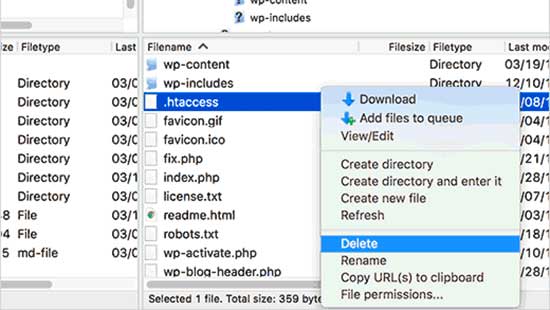
Następnie usuń plik .htaccess z twojej witryny internetowej.
Następnie otwórz katalog wp-admin i jeśli znajduje się tam plik .htaccess, to również go usuń.
Możesz teraz spróbować logować się do twojej witryny internetowej WordPress. Jeśli ci się to uda, oznacza to, że twój plik .htaccess uniemożliwiał ci logowanie się do WordPressa.
Po zalogowaniu się wystarczy przejść do strony Ustawienia ” Permalinki w panelu administracyjnym WordPress i kliknąć przycisk “Zapisz” bez wprowadzania żadnych zmian. Spowoduje to wygenerowanie nowego pliku .htaccess dla twojej witryny internetowej.
Metoda 4: Dezaktywacja wtyczek
Czasami wtyczki WordPress mogą powodować ten problem, zwłaszcza jeśli występuje konflikt między dwiema wtyczkami.
Aby łatwo wyłączyć wszystkie wtyczki WordPress, połącz się ze swoją witryną internetową za pomocą klienta FTP lub aplikacji Menedżer plików w kokpicie konta hostingowego.
Po połączeniu przejdź do katalogu /wp-content/. Wewnątrz niego zobaczysz katalog o nazwie “wtyczki”. To tutaj WordPress instaluje wszystkie twoje wtyczki.
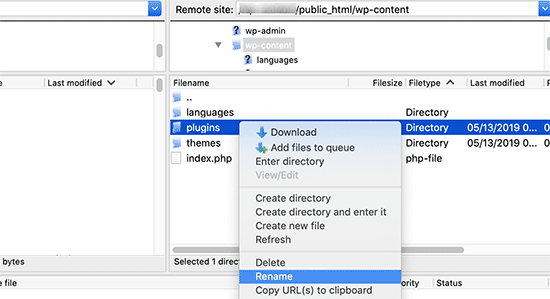
Wystarczy zmienić nazwę katalogu wtyczek na “plugins_backup”. Spowoduje to wyłączanie wszystkich wtyczek WordPress zainstalowanych na twojej witrynie internetowej.
Mamy również szczegółowy poradnik na temat wyłączania wszystkich wtyczek WordPress, gdy administrator WordPress jest niedostępny.
Po wyłączaniu wszystkich wtyczek spróbuj zalogować się do twojej witryny WordPress. Jeśli ci się to uda, oznacza to, że przyczyną problemu była jedna z twoich wtyczek.
Metoda 5: Powrót do domyślnego motywu
Motywy WordPress mogą również powodować konflikty po aktualizacji do nowszej wersji WordPressa lub samego motywu. Aby dowiedzieć się, czy problem jest powodowany przez twój motyw, musisz go wyłączyć.
Proces jest podobny do wyłączania wtyczek. Połącz się z twoją witryną internetową za pomocą klienta FTP. Następnie należy przejść do katalogu /wp-content/themes/ i zmienić nazwę obecnego, aktualnego katalogu motywu na “themes_backup”.
Gdy to zrobisz, spróbuj logować się ponownie. Jeśli ci się to uda, oznacza to, że przyczyną problemu był twój motyw.
Możesz teraz ponownie zainstalować nową kopię twojego motywu, aby sprawdzić, czy to rozwiąże problem. Jeśli problem pojawi się ponownie, będziesz musiał skontaktować się z pomocą techniczną twojego motywu lub przełączyć się na inny motyw WordPress.
Metoda 6: Ponowna instalacja rdzeni WordPressa
W rzadkich przypadkach problem z ciągłym odświeżaniem strony logowania może być spowodowany uszkodzeniem plików rdzenia WordPressa.
Te pliki rdzeni są podstawą twojej witryny internetowej WordPress i zarządzają podstawowymi funkcjami. Jeśli pliki te zostaną uszkodzone lub nadpisane nieprawidłowym kodem, może to prowadzić do różnych błędów, w tym problemów z logowaniem.
Najpierw przejdź na stronę WordPress.org i pobierz najnowszą wersję oprogramowania. Po pobraniu rozpakuj plik na twoim komputerze. Spowoduje to utworzenie katalogu o nazwie “wordpress” zawierającego wszystkie pliki niezbędne do ponownej instalacji.
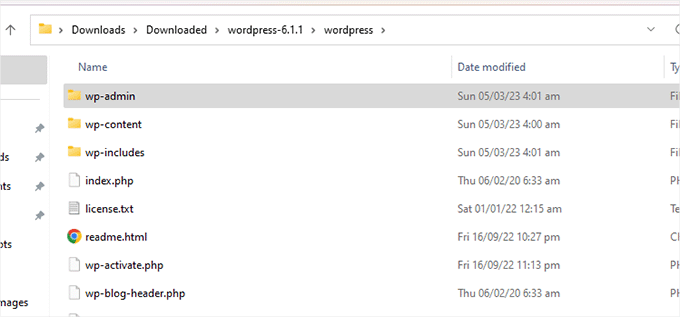
Następnie musisz połączyć się z twoją witryną internetową za pomocą klienta FTP lub menedżera plików dostarczonego przez dostawcę hostingu.
Po nawiązaniu połączenia przejdź do katalogu głównego twojej witryny internetowej. Jest to główny katalog, który zawiera katalogi takie jak wp-admin, wp-content i wp-includes.
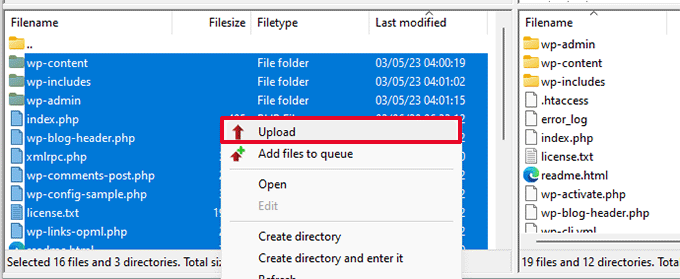
Na tym etapie pobierz wszystkie pliki z katalogu “wordpress” na twoim komputerze i prześlij je do katalogu głównego witryny internetowej.
Twój klient FTP poprosi o potwierdzenie nadpisania istniejących plików rdzeni.
Ponieważ usuniesz uszkodzone pliki rdzeni WordPressa i zastąpisz je nowymi, wybierz opcję “Nadpisz” i zaznacz opcję “Zawsze używaj tego działania”, aby uniknąć konieczności potwierdzania każdego pliku z osobna.
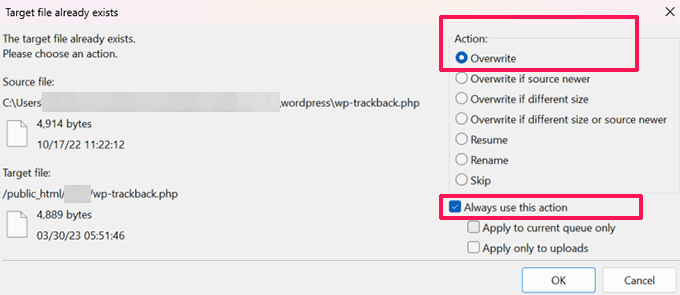
Na koniec kliknij “OK”, aby rozpocząć proces przesyłania. Twój klient FTP zastąpi rdzeń plików WordPress na twojej witrynie internetowej nowymi plikami z twojego komputera.
Po zakończeniu przesyłania przejdź na swoją witrynę internetową, aby sprawdzić, czy błąd został naprawiony. Jeśli problem z logowaniem jest spowodowany uszkodzonym plikiem rdzeni lub złośliwym oprogramowaniem, komunikat o błędzie powinien zniknąć i powinieneś być w stanie zalogować się pomyślnie.
Film instruktażowy
Jeśli potrzebujesz instrukcji wizualnych, obejrzyj poniższy film.
Co zrobić, jeśli nie można poprawić problemu z przekierowaniem logowania do WordPressa?
Jeśli próbowałeś wszystkiego, od czyszczenia plików cookie przeglądarki po dezaktywację motywów i wtyczek, ale problem nadal występuje, możesz spróbować poprosić o obsługę w społeczności WordPress.
Użytkownicy z grup takich jak grupa WPBeginner Engage na Facebooku mogli doświadczyć tego samego problemu co Ty i mogą udzielić wskazówek, co zrobić, aby rozwiązać problem strony logowania.
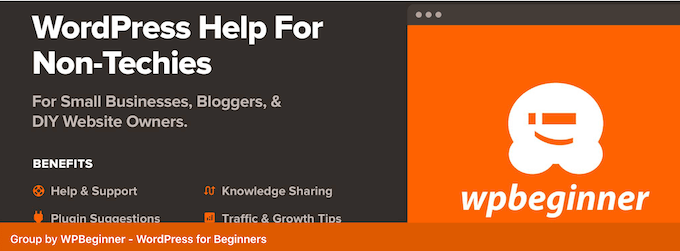
Poza tym możesz skorzystać z rozwiązań wsparcia WordPress, takich jak WPBeginner Pro Services. Oferujemy awaryjne wsparcie WordPress klasy premium, w ramach którego eksperci mogą określić, co dzieje się z twoją witryną i zająć się podstawową przyczyną problemu.
Możesz również wynająć nasze usługi konserwacji WordPress, aby zapobiec problemom, takim jak złośliwe oprogramowanie, wysokie przestoje i nieaktualny WordPress, które mogą mieć wpływ na twoją stronę internetową.
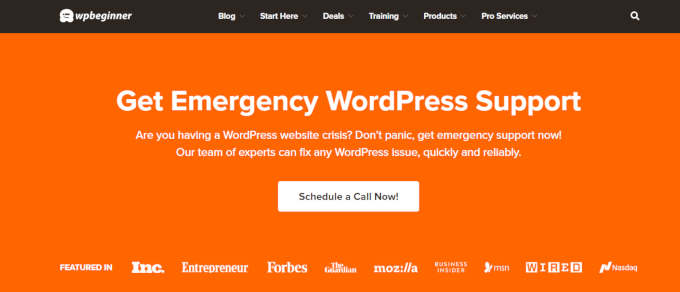
Zapraszamy do umówienia się na spotkanie z naszym zespołem już dziś, aby zobaczyć, co możemy zrobić, aby poprawić Twoją stronę internetową.
Dowiedz się więcej Rozwiązania problemów WordPress
Czy doświadczasz innych typowych błędów WordPress i musisz znaleźć sposób na ich poprawkę? Oto inne artykuły, które możesz sprawdzić:
- Jak poprawić błąd zbyt wielu przekierowań w WordPress?
- Jak łatwo naprawić błąd braku dostępu do witryny w WordPressie?
- Jak naprawiono błąd “Witryna ma problemy techniczne” w WordPressie?
- Jak naprawić wpisy WordPress zwracające błąd 404 (krok po kroku)
- Jak naprawiono błąd mieszania treści w WordPress (krok po kroku)
- Jak naprawić nieprawidłowy błąd JSON w WordPress (przewodnik dla początkujących)
- Jak znaleźć i uzyskać dostęp do dzienników błędów WordPress (krok po kroku)
- Jak naprawić problem z niewysyłaniem e-maili przez WordPress?
- Jak naprawić WordPressa, który utknął w trybie konserwacji (prosty sposób)
Mamy nadzieję, że ten artykuł pomógł ci rozwiązać problem z odświeżaniem i przekierowywaniem strony logowania WordPress. Możesz również zapoznać się z naszym kompletnym przewodnikiem po rozwiązywaniu problemów z WordPressem lub sprawdzić nasze najlepsze wtyczki i narzędzia WordPress do rozwoju witryny.
If you liked this article, then please subscribe to our YouTube Channel for WordPress video tutorials. You can also find us on Twitter and Facebook.





Eric
I had to rename /wp-content/object-cache.php. Hope that helps for anyone who the other steps don’t work for.
Alisha
When i type myurl.com/wp-admin the page shows blank. I can’t see any login panel either nor does my website opens… what is the cause?
WPBeginner Support
Please see How to fix the WordPress white screen of death.
Admin
Akeem
editing the wp-config worked like a charm. thank you so much!
Jeff
If you are having this issue, and nothing suggested here will work – log into the Cpanel and go into PHP My Admin, run a repair on your database table.
Micah
Adding the code to the wp-config.php solved this for me.
define(‘WP_HOME’,’http://example.com’);
define(‘WP_SITEURL’,’http://example.com’);
Thanks for the article! It took me 3 hours sifting through other posts before I found your post and the resolution that I needed!
Micah
MuhdNurHidayat
Thank you very much! You saved my day!!
Gordon
This problem can also occur if your server hosting WordPress has run out of disk space. Freeing up disk space can solve it.
Victor
You saved my day. I lost hours trying to find what the hell was wrong… thanks dude
Angelo
Deleting the .htaccess worked for me. Thank you
Friday0
Sir please help me look at what am getting it started this night.
Fatal error: Call to undefined function
wp_is_mobile() in /home/u318928021/
public_html/wp-login.php on line 39
I don’t know what to do
WPBeginner Support
Seems like a plugin or your WordPress theme is causing this error. Deactivate all your WordPress plugins and check if this resolves your issue. If it does then you need to reactivate plugins one by one. This will help you find the plugin causing the error. If deactivating all plugins does not resolve the issue, then switch to a default WordPress theme like Twenty Fifteen. If switching theme resolves the issue, then the problem is your with your WordPress theme.
Admin
Luis
Thanks, it was a plugin conflict. I just deleted some useless crap via ftp and now it’s all sorted.
Thomas Le Coz
You guys saved my ass. I was stuck outside a client site after messing with a SSL certificate and some stuff on managed account.
Never encountered this issue before, got saved by your guide.
Thanks
Eva Duli
Nothing of these work for me. I want to work the site localhost but when I am trying to login in the admin it redirects to the old admin login. Do you have any idea?
Marco Panichi
My problem was that I hadn’t renew the database and the provider denied my user to insert/update the database.
The error I received was: “INSERT command denied to user ‘Sqlxxxxxx’@’xx.xxx.xxx.xxx’ for…”
So the solution in my case was:
1) activate the debug into wp-config.php > define(‘WP_DEBUG’, true); in order to discover the problem
2) renew the database
Hope this help!
JohnnZenith
I have a wordpress.com blog and all these instructions either are not relevant or I do not understand them, so I guess i’m going to leave it.
WPBeginner Support
These instructions are for self hosted WordPress.org sites. Please see our guide on the difference between WordPress.com and WordPress.org
Admin
chris
I cant find my .htaccess file? I can find it in my rootfirectory but not on my subdomain (where I have a whole new wordpress site). What do I do? It is my first time ever to log in to my subdomain wordpress.
Kenny
The dreaded Internal Server Error and web host support quickly identified a corrupted .htaccess. Spent next 3 hours trying to find how to use my ImportBuddy when I didn’t have WP Admin access. Finally thought to check WPBeginner, found the .htaccess issue above and 30 seconds later had fixed the issue. Next time I come here first!
Thanks guys and gals.
Drew
Changing the wp-config.php file did it for me! This is the second time I’ve had this issue in two weeks, so I think the fix via htaccess was only a temporary solution.
joel
Seriously a life saver! Corrupted .htaccess files was my issue. But following your steps helped me solve it. Much, much appreciated!
Sumdi
Its working
Have rename .htaccess and update WP_HOME, WP_SITEURL to proper URL in wp-config.php file….
rubenjm
I had this issue, tried all these options and none worked for me.
Finnally solved it… apparently my database was overloaded!! I had to login through phpmyadmin and delete and clean some tables. Hope it helps someone!
Moises
Which tables clean you?
Liviu
I did all of the proposed solutions, but nothing works for me! It keeps refreshing and redirecting it back to the login screen. Changing the folder of my current theme gives the white screen of death. It doesn’t revert to the default theme. Any other idea, please?
Being at a dead end, I’m thinking to download all the site through ftp, make a new one site from WordPress and then upload one by one all my content. I’m worry however if I’ll be able to insert all the customization settings afterwards. The current theme was made custom by another person which cannot help anymore. Is it safe to do that? Thanks!
Mary Anne
Thank you so much. I have WordPress pages built via my account with bluehost. One of my wordpress sites stopped working. I had the white screen of death.
I followed each step in order, until I found the step that worked to resolve my problem. The step that worked for me was, Revert Back To Default Theme. Instead of using an ftp though, because I was having a hard time with my fetch working, I logged into my bluehost account and went into my file manager and then accessed my wpcontent/themes/directory that way for changing the title of my current theme.
this worked perfectly. I was able to log back in and choose a different theme. Thank you again
Mary
Manish
Hello,
Its not working for me. I had made every change into my site as per this tutorial still no luck. Added these two line in web config file.
define(‘WP_HOME’,’http://www.siteurl.com’);
define(‘WP_SITEURL’,’http://www.siteurl.com’);
deleted .htaccess file. but still same problem. My site running on 1&1 hosting.
Please help me.
Thanks
Manish
Umair
Dear manish , there is small change use it will definitely work
1define(‘WP_HOME’,’http://example.com/wp-admin’);
2define(‘WP_SITEURL’,’http://example.com’);
Abdul Ghani
Updating the site URL worked for me!
the wicked noodle
Clearing my cache and cookies fixed it right away. Thanks so much!
Claudia
Update Site URL worked perfect for me! Thank you!
WPBeginner Staff
Contact your web hosting service provider. If they are unable to help then switch to a better WordPress hosting solution.
Louis
Noting work for me… wp 3.9.1, Hostpapa hosting.
WPBeginner Staff
Try checking your server error logs. You can also try increasing php memory limit. Let us know if this helps.
Beck Abad Lastimosa
I have had my site for more than 6 months now and I finally decided to transfer hosting. After the transfer was successfully done, I as still able to access my login page. But these past few days has been a nightmare! I am was able to login to WP under the new DNS but as of this time, this problem suddenly occured:
– Everytime I login to WP admin, I should see the login page right? But what I get is a download of wp-login.php. I have tried checking issues ith the guide of WP Codex. I tried contacting GoDaddy (my new host) but they told me they do not handle coding, etc. Right now, I’m on a dead end! I have tried different browsers but I still get a download of wp-login.php instead of the login page showing itself.
I ould really appreciate it if you can help me.
Thilip kumar
I Check with all the above but unable to login, I can ablre to see the login window, after I submitting login form. I Displays ‘.’ (Dot symbol)
Alison Withers
You’re a godsend!!! Editing the config file to define the site address again did the trick.
Jaka
YES! This did it for me too. Magic! Thanks!
Isak
Did all of the above, nothing works. My main wp-login.php redirects me to one of my subdomains.
This is how the redirect problem occured:
1. My web hotel shut down my site, saying that it had been infected with malware.
2. I changed all my passwords via PhpMyAdmin as well as to the database.
3. I manually updated WP in my root directory as well as 2 out of 3 subdomains (the 3rd one already had the latest version) by uploading the new files and replacing the old ones, since I was not allowed to access my WP admin area.
4. I manually added a .htpasswd and .htaccess to my root WP install and tried to access wp-login.php. I tried my 3rd subdomain (the one with the latest install of WP) first and it worked. After that, I tried my main domain and came to a page saying “update database”, so I did. After that I tried again, but every time I try to reach my root install or any of the other subdomains, I get redirected to my 3rd subdomain.
Any ideas?
WPBeginner Support
Open the wp-config.php file on the root site. Add these two lines to your wp-config.php file:
define('WP_HOME','http://example.com');define('WP_SITEURL','http://example.com');1-click Use in WordPress
Replace example.com with your own domain. Also delete .htaccess file from all your subdomains and root domain. Once you get access to WordPress admin area on your root domain you need to go to Settings -> Permalinks and just save your permalink structure.
Admin
Jesse
Deleting .htaccess file from root directory worked for me. Thank you!!!
Moaz
none worked for me!
Diane
The extra lines in the wp-config worked! I love you! Thanks
carl
WP-config worked for me too! I could kiss you!
Jonny
WP_SITEURL did it for me. Seems illogical but it worked, so thanks for the tip! This only started happening recently to me – I wonder if it’s more prevalent with subdirectory installs with newer versions of WP.
igor
ok I deleted all plugins and it works but whenever I add any plugin it does the same thing
Anna
Thank You
It was really helpful, great info … Resolved y issue by adding site name in wp-config.
Regards,
Peter Evans
Recently WP started getting me to login ever 5 of so minutes. I noticed that my wp-config.php did not have the following lines
define(‘WP_HOME’,’http://example.com’);
define(‘WP_SITEURL’,’http://example.com’);
and when i inserted then the need to login was a less but I was then told that my session has expired and I needed to relogin in.
This is very frustrating and I would be greatful if you could assist me. I am using WP 3.6.1
Peter Evans
Aamna
and Yes if your wp-config.php file does not provide you a solution.
Try going to functions.php of your theme via ftp and add same two lines right below the <?php line and upload again. here you go !!!
it works for me
Aamna
Thanx a lot the site URL was the solution … Thank you Thank you Thank you
W.J.Kok
I use Epic Browser for testing because that browser will not store cookies (by default). Therefore clearing the caches will not delete all my stored passwords in the process.
W.J.Kok
Set chmod wp-admin at 750 did kill my admin login access. So, now I use 755.
Brent Norris
Had a special case of the redirects all day. This particular post, out of about 20 keyed me in on a solution. Just wanted to say, “thanks!” Your perspective was a refresh after ten hours chasing down a solution.
It was the part about generating a new .htaccess file that made the difference for me. Wish I could be more helpful to others but the problem I was having wasn’t very related and wouldn’t make a lot of sense to your readers.
Aloha
Editorial Staff
So glad that we were able to help you Brent
-Syed
Admin
Adrian
Thanks a lot for the ‘Update Site URL’ fix. That solved an issue I was battling with for a while and saves me from any further headaches.
Omar
This was really frustrating me but thanks to your tip on updating the URL my site is now working. Thanks!
Haseeb Ahmad Ayazi
This error is very rear with WordPress but mostly occir in Blogger
Paul
I normally get this error when working with multisite, normally it’s a cookie path problem which can be fixed by changing the wp-config.php.
Robert Connor
I really needed this tutorial it happens to me all the time usually a plug in conflict. I am addicted to plugins. Thanks staff! Have a great day on purpose…
Kartik eye
I had the same issue, few days ago. I was trying to enable the wpmultisite function for my new website with sub directories. My website is hosted on bluehost. I did everything step by step. But after editing all the files like wpconfig.php and htaccess. When I finally tried to login, I was getting a redirect to the same wp login page. I disabled the multiste and then everything was fine again. Please can you help with this?
lelebon
I tried everything — I said every little advice here — to no avail. Until I noticed I was using wp_config.php instead of wp-config.php. That simple! It solved my problem. HURRAY!!
Anyways, thanks for the tips. Hope I can help someone too.